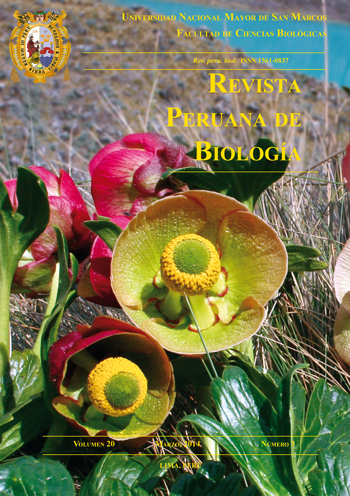Reproductive development of Krapfia weberbaueri(Ranunculaceae) under controlled conditions of light and temperature
DOI:
https://doi.org/10.15381/rpb.v20i3.5234Keywords:
Peru, Ancash, flowering, gynophore, nectar.Abstract
Krapfia weberbaueriStandl. & J. F. Macbr. is an endemic species from Peru, categorized as vulnerable, and distributed in the departments of Ancash, Huanuco, Junin and San Martin. This work reports the reproductive development of the species under controlled conditions of light and temperature (12 hours light/12 hours darkness, 12 °C during light hrs and 8 °C during dark hrs). Entire plants at reproductive stage were collected at Cordillera Blanca (Ancash), where it is found forming patches, at an elevation of 4200 to 4800 m. The species has large and showy flowers, which from anthesis to the onset of senescence remain responsive, however at a greater extent in the mature flower, stage at which the dehiscence of stamens and release of pollen grains reaches 100%. This period lasts a total of 13 days. Nectar production begins when the flower matures and continues until the total senescence of petals. The viability of the pollen grains varied from 78 to 97% and success in achene production was 38-62%. It may be noted that pollination is favored by the final position of anthers over the stigmas, nectar production, moderate presence and movement of mites and aphids, and the pendulous position of the flower.Downloads
Downloads
Published
Issue
Section
License
Copyright (c) 2013 Beatriz Roca, Mery Suni, Asunción Cano

This work is licensed under a Creative Commons Attribution-NonCommercial-ShareAlike 4.0 International License.
AUTHORS RETAIN THEIR RIGHTS:
a. Authors retain their trade mark rights and patent, and also on any process or procedure described in the article.
b. Authors retain their right to share, copy, distribute, perform and publicly communicate their article (eg, to place their article in an institutional repository or publish it in a book), with an acknowledgment of its initial publication in the Revista Peruana de Biologia.
c. Authors retain theirs right to make a subsequent publication of their work, to use the article or any part thereof (eg a compilation of his papers, lecture notes, thesis, or a book), always indicating its initial publication in the Revista Peruana de Biologia (the originator of the work, journal, volume, number and date).






